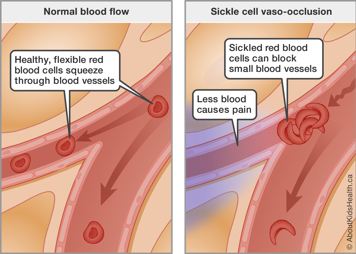Pain is like an alarm system for your body. When you are injured, the alarm system goes off, sending a pain message through your nervous system from the site of injury to your spinal cord and brain. Once your brain receives the pain message, it decides if there is a threat and if your body needs to respond to keep you safe.
Pain can affect many aspects of your life. For instance, it can bring down your mood and interfere with your sleep and other activities, such as attending school or work, participating in sports, enjoying hobbies and seeing friends.
Acute pain
In cases of acute (sudden, brief) pain, the alarm system remains active after an injury to help warn you of possible danger and protect you while you heal. Over time, as the body recovers, the alarm system normally sends fewer messages to your brain until the acute pain eventually goes away.
Acute pain can have many different causes. The most common cause in people with sickle cell disease is the sickling of red blood cells. When sickle cells clog a small blood vessel, less blood (and, as a result, less oxygen) gets to the area supplied by that blood vessel. This causes inflammation and pain in what is called a vaso-occlusive crisis, or pain episode.
An acute pain episode is the most common reason for people with sickle cell disease to seek medical care. Pain can occur anywhere in the body, but it most often occurs in the arms, legs, chest, back and abdomen.

Chronic pain

Chronic pain (or persistent pain) is pain that lasts over a period of time. Someone with sickle cell disease can experience both chronic pain and acute pain episodes.
Chronic pain often results from changes in the sensitivity of your nerves, spinal cord and brain. In some people, the nervous system becomes “hypersensitive” to a pain message after an injury. As a result, the brain continues to interpret the firing of the nerves as a feeling of pain even though the injury has already healed and there is no danger. In effect, it is receiving a false alarm.
The cause of chronic pain can be different from that of acute pain. Possible causes include bone and joint problems.






